Why don't children walk to school? What makes a community walkable?
Recently I had the good fortune to receive a presentation from UW professor Anne Vernez Moudon at a meeting of the Seattle Pedestrian Advisory Board. Dr. Moudon is developing tools for auditing walkability of communities.
Among the support for commonly-held walkable planning concepts were some new numerical observations. One is that the closer your home is to a large office complex, the less likely you are to walk enough each day to maintain good health.
There are some obvious factors to support this. Office districts have fewer shops or other destinations that people are likely to walk to if they're close enough. Also, newer (post-1930 I guess) office and commercial developments are seldom designed for walkers, and suburban areas definitely haven't had zoning to require those sidewalks and property-line construction that support walking.
As I anecdotally noticed in my Walk to Work, even in residential areas few children seem to be walking to school in the suburbs. So what happens when you take a school and put it in the middle of a suburban commercial district?
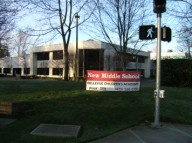 Every day I walk past the Redmond campus of the private Bellevue Children's Academy, located at 14949 NE 40th Street. It's in a generic warehouse/office/commercial complex, and one of many within a few blocks. The only thing interrupting these one-story structures are the taller Microsoft buildings slowly pushing other companies out of the area. I really enjoy seeing recycled structures being used for a purpose their developer never could have imagined.
Every day I walk past the Redmond campus of the private Bellevue Children's Academy, located at 14949 NE 40th Street. It's in a generic warehouse/office/commercial complex, and one of many within a few blocks. The only thing interrupting these one-story structures are the taller Microsoft buildings slowly pushing other companies out of the area. I really enjoy seeing recycled structures being used for a purpose their developer never could have imagined.
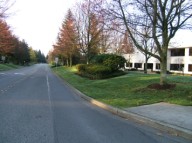 The major problem here is that the infrastructure one would expect at a school is totally missing. There are no sidewalks on the east or west side of the complex. This is on the east, 150th NE.
The major problem here is that the infrastructure one would expect at a school is totally missing. There are no sidewalks on the east or west side of the complex. This is on the east, 150th NE.
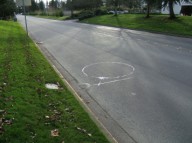 In fact, there are no sidewalks on 150th NE south of NE 40th at all. Just a berm on either side to quiet down the office complexes and redirect errant vehicles.
In fact, there are no sidewalks on 150th NE south of NE 40th at all. Just a berm on either side to quiet down the office complexes and redirect errant vehicles.
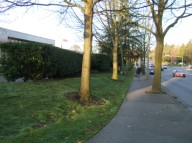 The north side of the property, along NE 40th street, does have a sidewalk. Unfortunately another berm - hedged this time - sits between the sidewalk and the school. It does serve to reduce traffic noise, but it also doesn't let anyone into the school or the businesses.
The north side of the property, along NE 40th street, does have a sidewalk. Unfortunately another berm - hedged this time - sits between the sidewalk and the school. It does serve to reduce traffic noise, but it also doesn't let anyone into the school or the businesses.
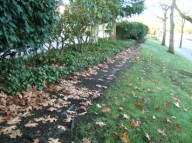
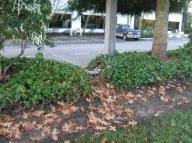
There are surprisingly few social trails worn through the berm - in fact just one midblock.
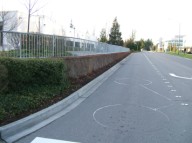
This is the west side, which is confusingly unnamed but becomes 150th NE north of 40th. When the Microsoft building across the street to the right was built, the driveway was improved and a sidewalk installed on the Microsoft side. However, only a retaining wall was built over by the school.
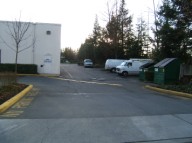 There are only two ways in, driveways on the west and east. Here on the east the dumpsters are stored in a convenient place for garbage men. Walkers have to go right past the trash while dodging cars that dart in, not expecting people to be in the middle of the driveway.
There are only two ways in, driveways on the west and east. Here on the east the dumpsters are stored in a convenient place for garbage men. Walkers have to go right past the trash while dodging cars that dart in, not expecting people to be in the middle of the driveway.
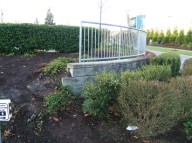 Other than the driveways, this appears to be the main pedestrian entrance. It's on the northwest corner. I didn't even notice it as a social trail until I saw two joggers cut through it at lunch time.
Other than the driveways, this appears to be the main pedestrian entrance. It's on the northwest corner. I didn't even notice it as a social trail until I saw two joggers cut through it at lunch time.
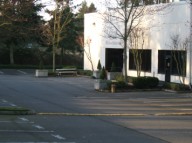 This building entrance at the southeast corner was the front door of the school before they added the middle school on. One parking spot has been taken over for a picnic table. Around the divider they've hidden the smokers' ashtray. Teachers escort children from their parents' cars here every morning, as they drop them off on the way to work.
This building entrance at the southeast corner was the front door of the school before they added the middle school on. One parking spot has been taken over for a picnic table. Around the divider they've hidden the smokers' ashtray. Teachers escort children from their parents' cars here every morning, as they drop them off on the way to work.
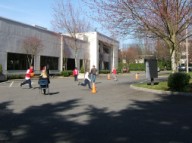 When the weather's nice, they cone off this area at lunch time and let the children use it like a black-top. The berms provide a nice barrier to the passing traffic, and the teacher watching makes sure everyone's safe. Certainly every school has a concrete or asphalt area for kids to play on right next to the school building. But in elementary school I remember making mud patties, examining insects, and playing dirt or grass-based sports. These kids don't have that opportunity. There isn't even a park anywhere nearby.
When the weather's nice, they cone off this area at lunch time and let the children use it like a black-top. The berms provide a nice barrier to the passing traffic, and the teacher watching makes sure everyone's safe. Certainly every school has a concrete or asphalt area for kids to play on right next to the school building. But in elementary school I remember making mud patties, examining insects, and playing dirt or grass-based sports. These kids don't have that opportunity. There isn't even a park anywhere nearby.
I know people whose kids go to this school, so I'm sure the quality of education is good. My point isn't to criticize them or even their choice of location. It's centrally located for the thousands of Microsoft employees with kids, and with other businesses in the area there is a natural customer base.
I'm really just trying to provide the street-level details of how badly off our auto-based suburbs really are, and why people living near office and commercial districts don't walk enough to stay healthy. As the character of neighborhoods and business change, we're left with structures and infrastructure that are best suited to cars, and prove to be obstacles for walkers.
Just two blocks from the school there is a major ped/bike path running along 520, so these properties should be able to draw in employees and customers from all over the area. Locally, Microsoft has been cutting back its cafeteria offerings and the dine-out crowd is significant. There are a few delis and small restaurants located in the office developments. People regularly jay-walk to get to them though, or walk down streets without sidewalks with semis driving by. Many people drive two blocks to get lunch.
In this spot, the City of Redmond probably has nothing to worry about long term. There's a significant chance that all of the commercial property in the area will eventually be bought and redeveloped by Microsoft. During redevelopment they'll put in missing pedestrian infrastructure. If Dr. Moudon's observations hold up, though, this can only be bad for the apartments and houses nearby, though. The few remaining businesses and innovative reuses like delis and the school will be eliminated, giving them absolutely nothing to walk to.
Meanwhile, other suburban areas of our region and the country that aren't lucky enough to have a massive redeveloper like Microsoft will continue to struggle with the sprawling office and commercial structures and their auto-only design.
